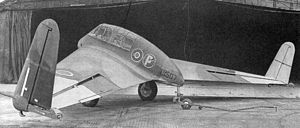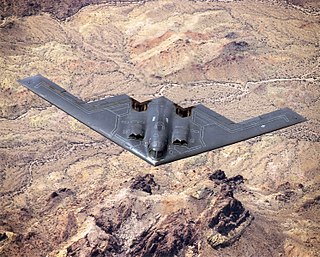
A flying wing is a tailless fixed-wing aircraft that has no definite fuselage, with its crew, payload, fuel, and equipment housed inside the main wing structure. A flying wing may have various small protuberances such as pods, nacelles, blisters, booms, or vertical stabilizers.

Squadron Leader Robert Kronfeld, AFC was an Austrian-born gliding champion and sailplane designer of the 1920s and 30s. He became a British subject and an RAF test pilot. He was killed testing a glider in 1948.
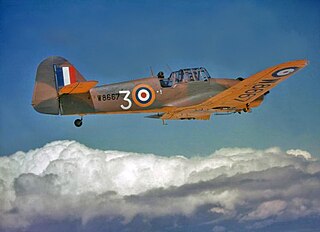
The Miles M.9 Master was a British two-seat monoplane advanced trainer designed and built by aviation company Miles Aircraft Ltd. It was inducted in large numbers into both the Royal Air Force (RAF) and Fleet Air Arm (FAA) during the Second World War.

The Royal Aircraft Factory S.E.5 is a British biplane fighter aircraft of the First World War. It was developed at the Royal Aircraft Factory by a team consisting of Henry Folland, John Kenworthy and Major Frank Goodden. It was one of the fastest aircraft of the war, while being both stable and relatively manoeuvrable. According to aviation author Robert Jackson, the S.E.5 was: "the nimble fighter that has since been described as the 'Spitfire of World War One'".

The de Havilland DH 108 "Swallow" was a British experimental aircraft designed by John Carver Meadows Frost in October 1945. The DH 108 featured a tailless, swept wing with a single vertical stabilizer, similar to the layout of the wartime German Messerschmitt Me 163 Komet. Initially designed to evaluate swept wing handling characteristics at low and high subsonic speeds for the proposed early tailless design of the Comet airliner, three examples of the DH 108 were built to Air Ministry specifications E.18/45. With the adoption of a conventional tail for the Comet, the aircraft were used instead to investigate swept wing handling up to supersonic speeds. All three prototypes were lost in fatal crashes.

The Armstrong Whitworth A.W.52 was an early flying wing aircraft designed and produced by British aircraft manufacturer Armstrong Whitworth Aircraft.

The Baynes Bat was an experimental glider of the Second World War, designed by L. E. Baynes. It was used to test the tailless design that he had suggested as a means to convert tanks into temporary gliders so they could be flown into battle.

The Short SB.5 was a "highly unorthodox, adjustable wing" British research aircraft designed by Short Brothers in response to the UK Air Ministry requirement ER.100; to provide input for the design of the English Electric P.1 by testing the low speed flight characteristics of various configurations of wing-sweep required for supersonic flight. The tailplane could be mounted either on top of the fin ("T-tail") or below the fuselage. The tests ultimately confirmed that the original P.1/Lightning design was an effective configuration for high speed flight.

The Short SB.4 Sherpa was an experimental aircraft designed and produced by the British aircraft manufacturer Short Brothers. Only a single example was ever produced.
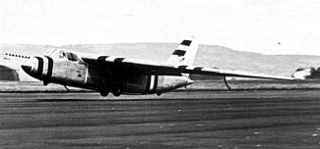
The Short SB.1 was a British tailless glider designed by David Keith-Lucas and Professor Geoffrey T.R. Hill. Built by Shorts as a private research venture to test the concept of the aero-isoclinic wing, it was the first aircraft to incorporate this feature.

The Boulton Paul Balliol and Sea Balliol are monoplane advanced trainer aircraft designed and produced by the British aircraft manufacturer Boulton Paul Aircraft. On 17 May 1948, it became the world's first single-engined turboprop aircraft to fly. The Balliol was operated primarily by both the Royal Air Force (RAF) and the Royal Navy Fleet Air Arm (FAA).

The Short Sturgeon was a planned British carrier-borne reconnaissance bomber whose development began during Second World War with the S.6/43 requirement for a high-performance torpedo bomber, which was later refined into the S.11/43 requirement which was won by the Sturgeon. With the end of the war in the Pacific production of the aircraft carriers from which the Sturgeon was intended to operate was suspended and the original reconnaissance bomber specification was cancelled.

Pterodactyl was the name given to a series of experimental tailless aircraft designs developed by G. T. R. Hill in the 1920s and early 1930s. Named after the genus Pterodactylus, a well-known type of Pterosaur commonly known as the pterodactyl, all but the first were produced by Westland Aircraft Ltd after Hill joined them.

The RAE Scarab was a light single-engined single-seat parasol winged modification of the de Havilland Humming Bird, flying in the United Kingdom in 1932. Only one was built.
The Parnall Parasol was an experimental parasol winged aircraft design to measure the aerodynamic forces on wings in flight. Two were built and flown in the early 1930s in the UK.

The Dunne D.8 of 1912 was a tailless swept wing biplane, designed by J. W. Dunne to have inherent stability. One example was supplied to RAE Farnborough. License-built Burgess-Dunne models were used by the US Signal Corps and United States Navy and the short-lived Canadian Aviation Corps. It was the latter's first and only warplane.
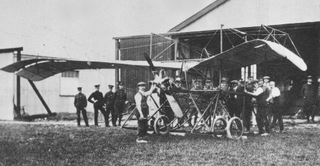
The Dunne D.7 was one of J. W. Dunne's swept wing tailless aircraft designed to have automatic stability, first flying in 1911. It was a single seat, single engined pusher monoplane developed from the unsuccessful D.6.
The NRC tailless glider, also called the NRL tailless glider, was a two-seat tailless research glider designed by the National Research Council of Canada and built by the National Research Laboratories, at the instigation of G.T.R. Hill who had previously designed the British Westland-Hill Pterodactyl series of tailless aircraft.
The Airborne Forces Experimental Establishment (AFEE) was a branch of the British Air Ministry, that researched and developed non-traditional airborne applications, such as gliders, rotary wing aircraft, and dropping of personnel and equipment by parachute, in the period 1942–1950.

The Zeppelin-Lindau CL.II was a German single-engine two-seat biplane with an all metal structure, built by Zeppelin-Lindau during World War I.
